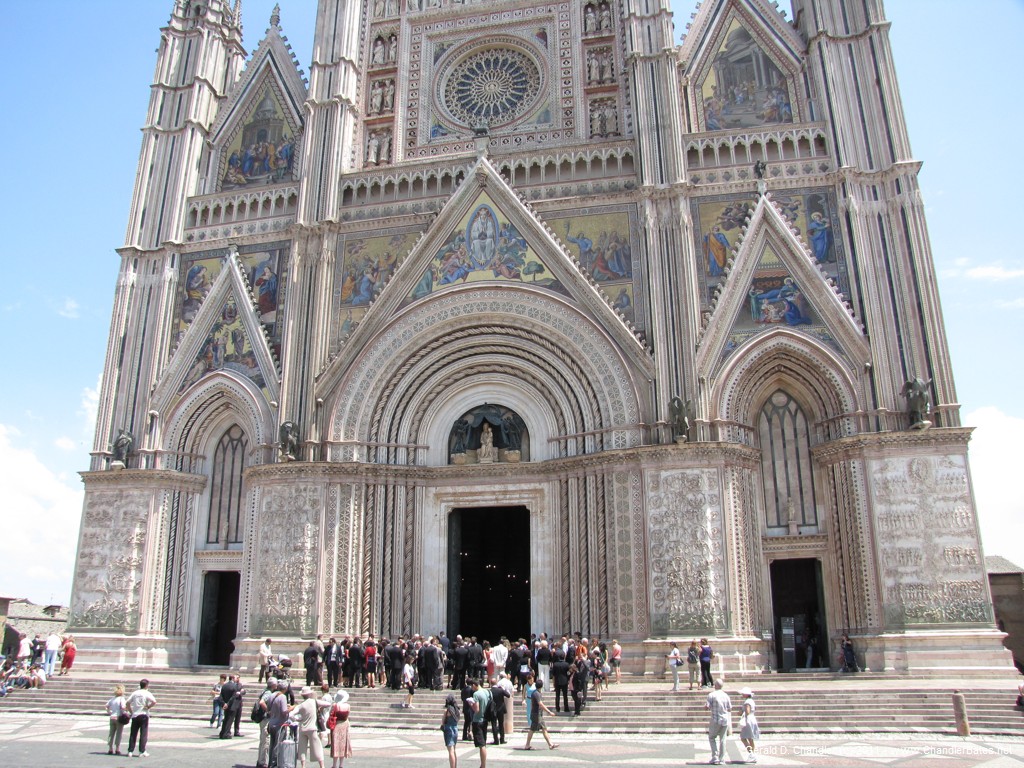Front Page | Home | Blog | Index | Site Map | Contact
![]() Rome
Rome
![]() Orvieto
Orvieto
![]() Viterbo
Viterbo
![]() Tivoli
Tivoli
![]() Ostia Antica
Ostia Antica
![]() Florence
Florence
![]() Lucca
Lucca
![]() Siena
Siena
![]() Pisa
Pisa
![]() San Gimignano
San Gimignano
![]() Prato
Prato
![]() Bologna
Bologna
![]() Assisi
Assisi
![]() Perugia
Perugia
![]() Urbino
Urbino
![]() Ravenna
Ravenna
![]() Parma
Parma
![]() Milan
Milan
![]() Bergamo
Bergamo

2011 Frontpages & Stays
2010 Fronpages & Stays
2009 Frontpages & Stays
2008 Front Pages
2007 Front Pages
2006 Front Pages
- 2006.12.12
- 2006.11.21
- 2006.11.04
- 2006.10.23
- 2006.10.09
- 2006.09.26
- 2006.09.10
- 2006.07.15
- 2006.05.30
- 2006.01.01

Orvieto Duomo Facade |
Coming from Florence to Rome we passed near, but below Orvieto, which sits on a volcanic plug. We wished that we could have stopped there and explored on the day but we had too much baggage. Through the miracle of the Internet we bought our train tickets to get there. You might wonder at this being mentioned now, but until this point in Italy we had always gone to the station to buy tickets; the automatic machines are fast and sure: one walks away with a ticket in hand. But this time we had learned the system well enough, had learned where and how to print our tickets, and had plenty of time to do it all in advance.
We managed to do a bit of reading before hand, both in Wikipedia and two different editions of the Michelin Green guide. So we were all primed to see Orvieto Cathedral, the Palazzo del Capitano del Popolo,
We left our Rome apartment in the early morning to catch a bus to the Termini train station, where we bought a typical Italian breakfast with a twist: Italians eat pastries and drink coffee for breakfast. Neither of us drinks real coffee and for some reason McDonald's doesn't sell decaf, so as a special offer, we got a pastry with orange juice instead of cofee. That was fine, because Jan could walk across the hall and buy a decaf capuccino to take away from the competition.
The train ride went quickly. We had reserved seats in a six-seat compartment. The train was going on to Florence and then Milan after Orvieto so we were unusual in that we didn't have big suitcases to carry. We got to Orviet right on time at 9:30 and wandered out of the station to see what we could see. Across the street we noticed a minibus and behind it a building that we quickly learned held the funicular railway. For one euro it takes you up the side of the volcanic plug to the old walled city of Orvieto.
Our first job on arriving in the square in front of the upper funicular station, was to get our bearings. The map we had in our guide book wasn't very good and so we were looking for somewhere to buy a decent map and maybe even a guide book of the town if the price was right. We succeeded on both scores getting a very good guidebook including map for six euros.
Our second job was to admire the view. Being up on a small plateau, the views of the countryside from the "edge" of the town are wonderful. We found a plaza that was indeed right on the edge and spent a pleasant ten minutes admiring and capturing the views.
And then, finally, we penetrated into the old city itself, walking the main street of town as it gently climbs into the center. En route we visited a small church, checked out possible lunch spots, and pretty soon were within a block of the cathedral, that is set off the main drag. It did not disappoint.
Jan's first impression was that the modern facade of the Cathedral of Florence must be based on the Orvieto facade, designed by Maitani in the 14th century. It is a most beautiful facade as the photo at the top of the page shows. Made up of ten sections, it is extremely easy on the eye, full of color, and embellished with lovely, but not original mosaics. The lower third of the facade is divided into three parts, each with a doorway into the church and the spaces between adorned with an amazing set of 14th century reliefs telling the story, basically, of the old and new testaments. The middle section has three rounded arches topped by three pointed arches and the flat spaces between and around the arches are filled with mosaics. The upper third has a rose window in the center, surrounded on three sides by pairs of statues that depict the twelve prophets and the twelve apostles of the church. On either side of the rose window and above it are more pinnacled arches with mosaics. It is not an exhaustive description, but you can surely tell what a masterpiece it is.
The inside of the church is a bit disappointing at first. It's small, bare, with just a few remnant frescoes in empty statue niches along the sides. The really amazing stuff, however, is in the side chapels and the apse, all resplendent in large scale 14th century frescoes. The date is important because the style is a bit like a comic book. The paintings always tell a story, often a multi-event story and are almost always depict people wearing 14th century Italian dress. They are painted in bright, vivid colors, and literally make the jaw drop.
The other attraction inside the church is the sculpture. There are a couple of extremely beautiful relief sculptures of episodes from the life of Mary: the annunciation, the visitation, and statues of Adam, Eve, and a wonderful "pieta" group with Mary holding the dead Christ accompanied by Mary Magdelene and Joseph of Arimethrea (??). Sculpted from a single piece of white marble, it is a stunning piece.